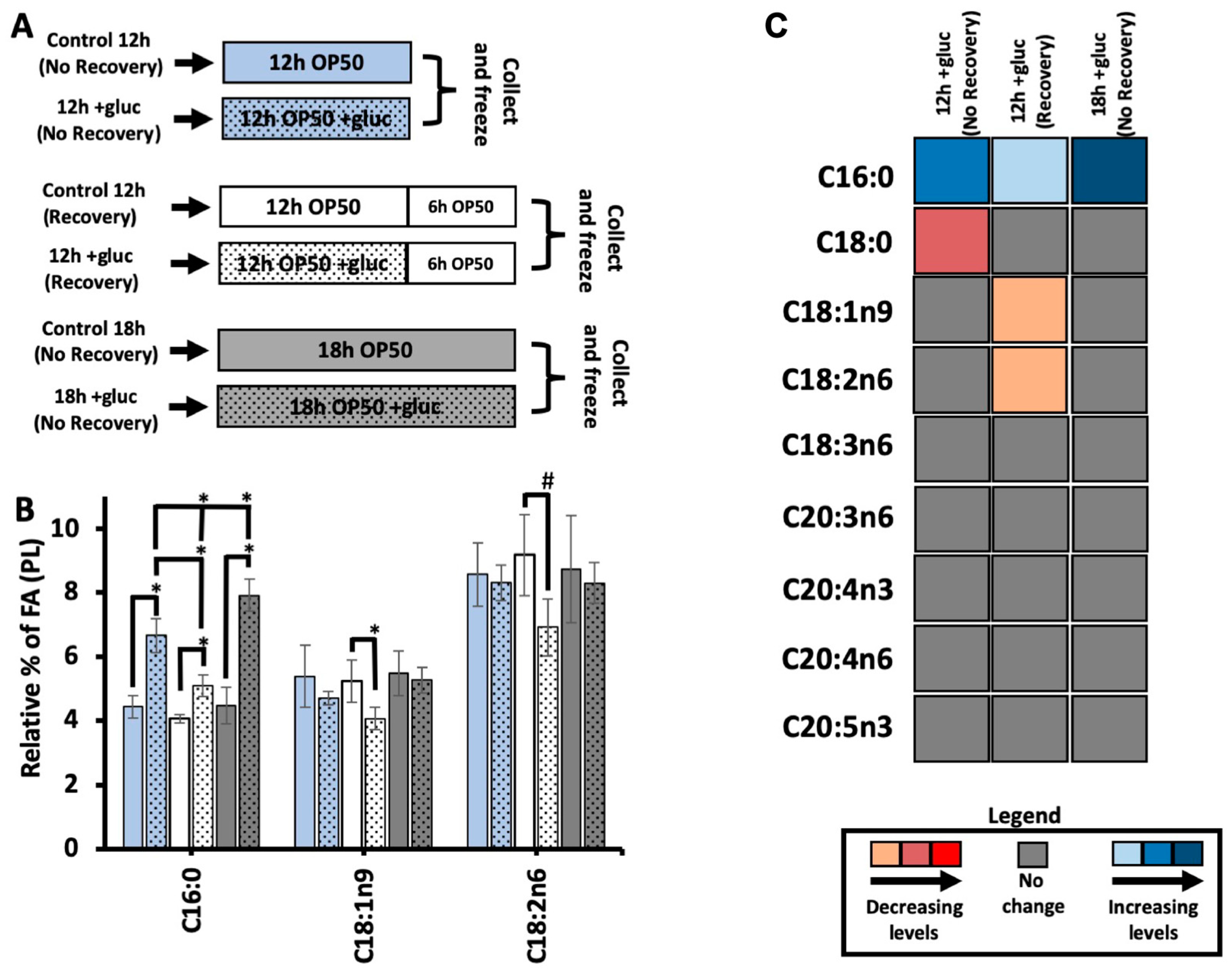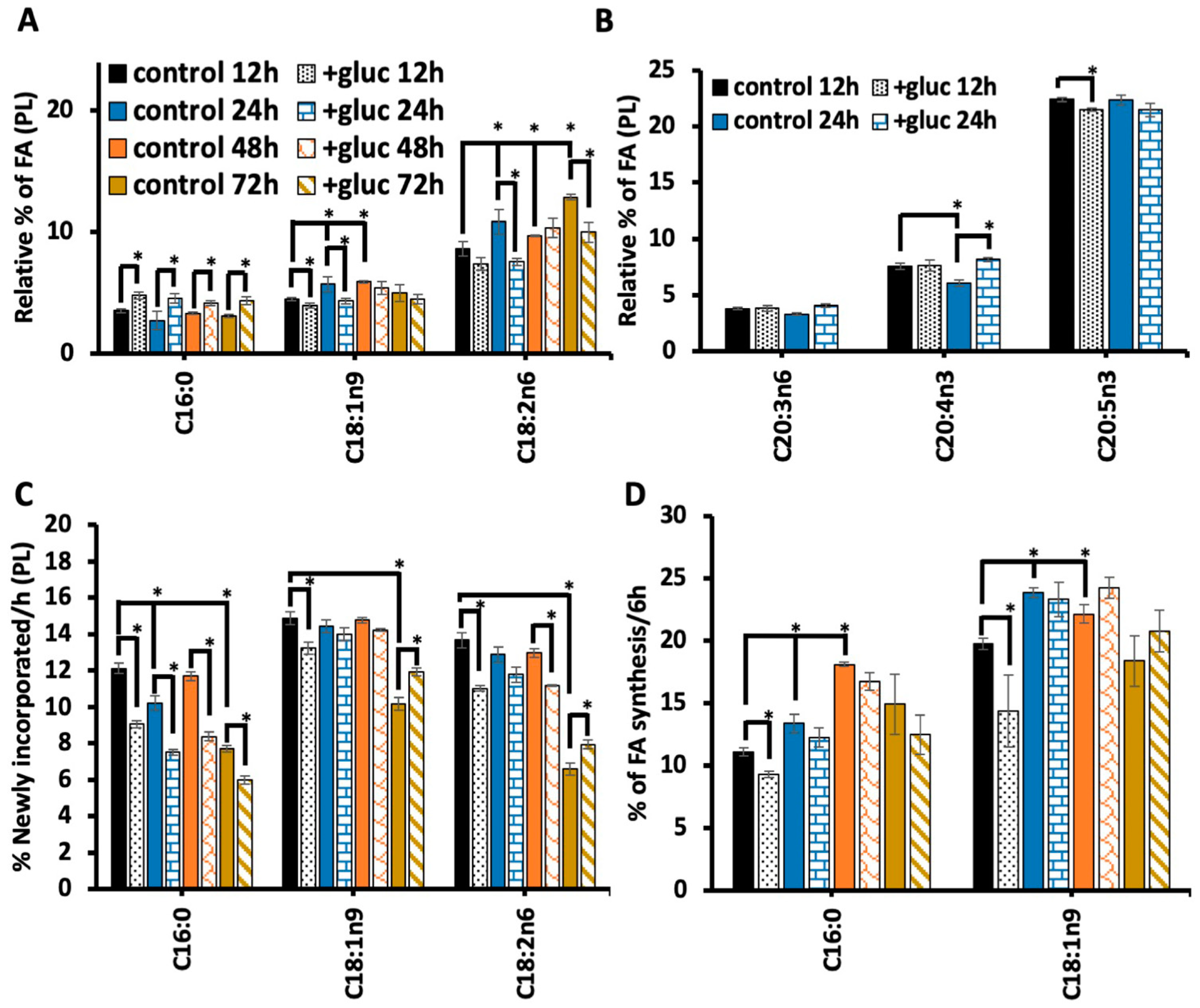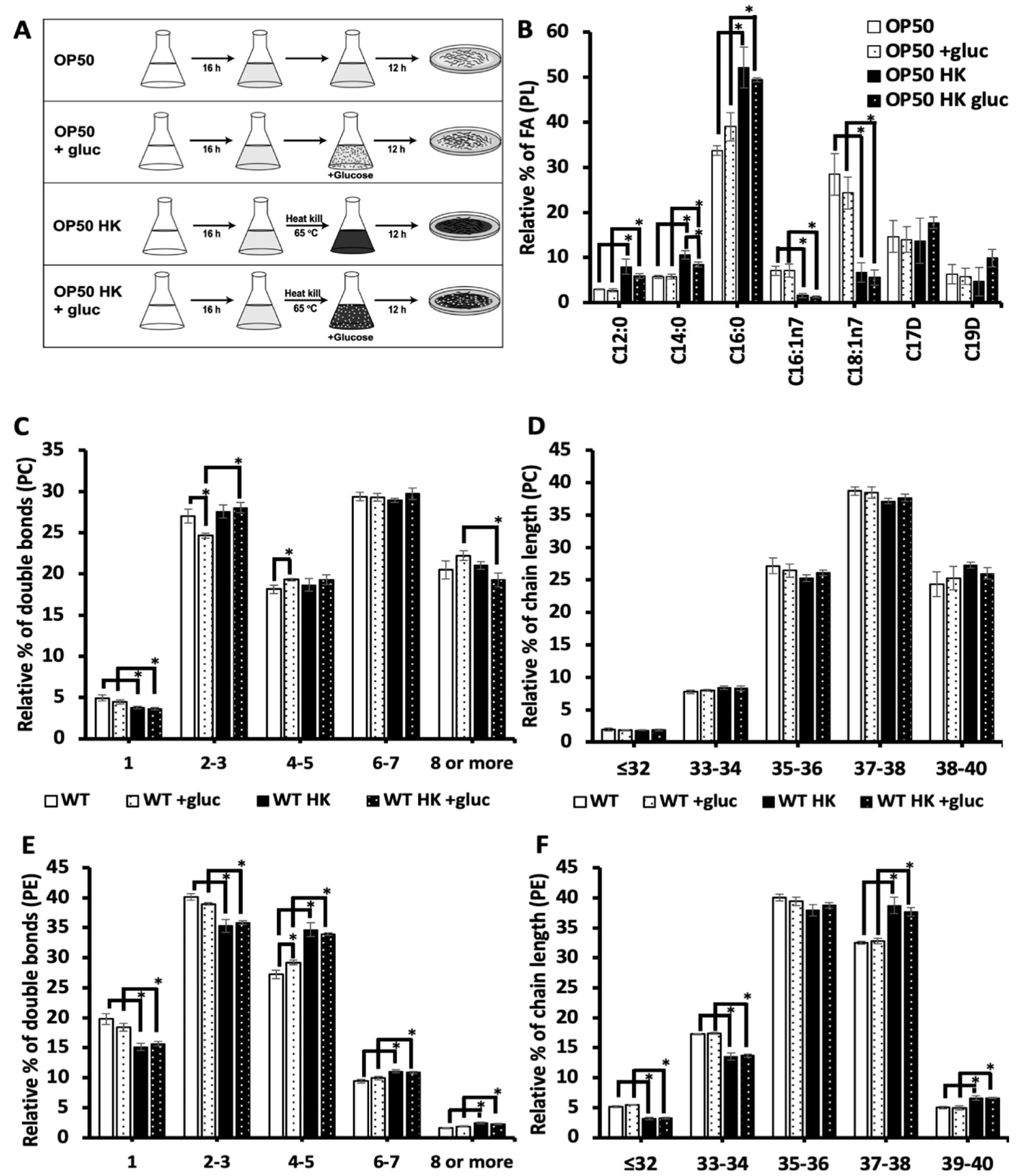Oleic Acid Metabolism in Response to Glucose in C. elegans
Abstract
1. Introduction
2. Materials and Methods
2.1. Maintenance of Strains and Population Synchronization
2.2. Stress Conditions, Labeling Strategy, and Time-Course Experiments
2.3. Conditions with Recovery Period after Glucose Stress
2.4. Lifespan Analysis
2.5. Heat-Killed Bacteria Tests
2.6. Lipid Extraction and GC Analysis
2.7. Quantification the Synthesis of Fatty Acids
2.8. Phospholipid Extraction and Analysis Using HPLC-MS/MS
3. Results
3.1. High Dietary Glucose Alters the Allocation of Oleic Acid to the Membrane
3.2. A Recovery Period Is Needed to Drive the Shift in C18:1n9 Abundance
3.3. The Abundance of Oleate and Linoleate Stabilizes with Longer Glucose Exposure
3.4. Living Bacteria Is Needed for the Impact of Glucose Stress on the Membrane
4. Discussion
5. Conclusions
Supplementary Materials
Author Contributions
Funding
Institutional Review Board Statement
Informed Consent Statement
Data Availability Statement
Conflicts of Interest
References
- Chen, Y.L.; Tao, J.; Zhao, P.J.; Tang, W.; Xu, J.P.; Zhang, K.Q.; Zou, C.G. Adiponectin Receptor PAQR-2 Signaling Senses Low Temperature to Promote C. elegans Longevity by Regulating Autophagy. Nat. Commun. 2019, 10, 2602. [Google Scholar] [CrossRef] [PubMed]
- Svensk, E.; Ståhlman, M.; Andersson, C.H.; Johansson, M.; Borén, J.; Pilon, M. PAQR-2 Regulates Fatty Acid Desaturation during Cold Adaptation in C. elegans. PLoS Genet. 2013, 9, e1003801. [Google Scholar] [CrossRef] [PubMed]
- Farkas, T.; Fodor, E.; Kitajka, K.; Halver, J.E. Response of Fish Membranes to Environmental Temperature. Aquac. Res. 2001, 32, 645–655. [Google Scholar] [CrossRef]
- Ruiz, M.; Ståhlman, M.; Borén, J.; Pilon, M. AdipoR1 and AdipoR2 Maintain Membrane Fluidity in Most Human Cell Types and Independently of Adiponectin. J. Lipid Res. 2019, 60, 995–1004. [Google Scholar] [CrossRef] [PubMed]
- Pilon, M. Paradigm Shift: The Primary Function of the “Adiponectin Receptors” Is to Regulate Cell Membrane Composition. Lipids Health Dis. 2021, 20, 43. [Google Scholar] [CrossRef]
- Yang, X.; Sheng, W.; Sun, G.Y.; Lee, J.C.M. Effects of Fatty Acid Unsaturation Numbers on Membrane Fluidity and α-Secretase-Dependent Amyloid Precursor Protein Processing. Neurochem. Int. 2011, 58, 321–329. [Google Scholar] [CrossRef]
- Vieira, A.F.C.; Xatse, M.A.; Tifeki, H.; Diot, C.; Walhout, A.J.M.; Olsen, C.P. Monomethyl Branched-Chain Fatty Acids Are Critical for Caenorhabitis elegans Survival in Elevated Glucose Conditions. J. Biol. Chem. 2022, 298, 101444. [Google Scholar] [CrossRef]
- Svensk, E.; Devkota, R.; Ståhlman, M.; Ranji, P.; Rauthan, M.; Magnusson, F.; Hammarsten, S.; Johansson, M.; Borén, J.; Pilon, M. Caenorhabditis elegans PAQR-2 and IGLR-2 Protect against Glucose Toxicity by Modulating Membrane Lipid Composition. PLoS Genet. 2016, 12, e1005982. [Google Scholar] [CrossRef]
- Devkota, R.; Svensk, E.; Ruiz, M.; Ståhlman, M.; Borén, J.; Pilon, M. The Adiponectin Receptor AdipoR2 and Its Caenorhabditis elegans Homolog PAQR-2 Prevent Membrane Rigidification by Exogenous Saturated Fatty Acids. PLoS Genet. 2017, 13, e1007004. [Google Scholar] [CrossRef]
- Zhu, H.; Shen, H.; Sewell, A.K.; Kniazeva, M.; Han, M. A Novel Sphingolipid-TORC1 Pathway Critically Promotes Postembryonic Development in Caenorhabditis elegans. eLife 2013, 2, e00429. [Google Scholar] [CrossRef]
- Perez, C.L.; Van Gilst, M.R. A 13C Isotope Labeling Strategy Reveals the Influence of Insulin Signaling on Lipogenesis in C. elegans. Cell Metab. 2008, 8, 266–274. [Google Scholar] [CrossRef] [PubMed]
- Dancy, B.C.R.; Chen, S.W.; Drechsler, R.; Gafken, P.R.; Olsen, C.P. 13C- and 15N-Labeling Strategies Combined with Mass Spectrometry Comprehensively Quantify Phospholipid Dynamics in C. elegans. PLoS ONE 2015, 10, e0141850. [Google Scholar] [CrossRef] [PubMed]
- Watts, J.L. Using Caenorhabditis elegans to Uncover Conserved Functions of Omega-3 and Omega-6 Fatty Acids. J. Clin. Med. 2016, 5, 19. [Google Scholar] [CrossRef] [PubMed]
- Watts, J.L.; Browse, J. Genetic Dissection of Polyunsaturated Fatty Acid Synthesis in Caenorhabditis elegans. Proc. Natl. Acad. Sci. USA 2002, 99, 5854–5859. [Google Scholar] [CrossRef] [PubMed]
- Brock, T.J.; Browse, J.; Watts, J.L. Fatty Acid Desaturation and the Regulation of Adiposity in Caenorhabditis elegans. Genetics 2007, 176, 865–875. [Google Scholar] [CrossRef] [PubMed]
- Alcántar-Fernández, J.; Navarro, R.E.; Salazar-Martínez, A.M.; Pérez-Andrade, M.E.; Miranda-Ríos, J. Caenorhabditis elegans Respond to High-Glucose Diets through a Network of Stress-Responsive Transcription Factors. PLoS ONE 2018, 13, e0199888. [Google Scholar] [CrossRef]
- Lee, D.; Jeong, D.E.; Son, H.G.; Yamaoka, Y.; Kim, H.; Seo, K.; Khan, A.A.; Roh, T.Y.; Moon, D.W.; Lee, Y.; et al. SREBP and MDT-15 Protect C. elegans from Glucose-Induced Accelerated Aging by Preventing Accumulation of Saturated Fat. Genes Dev. 2015, 29, 2490–2503. [Google Scholar] [CrossRef]
- Nomura, T.; Horikawa, M.; Shimamura, S.; Hashimoto, T.; Sakamoto, K. Fat Accumulation in Caenorhabditis elegans Is Mediated by SREBP Homolog SBP-1. Genes Nutr. 2010, 5, 17–27. [Google Scholar] [CrossRef]
- Diot, C.; García-González, A.P.; Vieira, A.F.; Walker, M.; Honeywell, M.; Doyle, H.; Ponomarova, O.; Rivera, Y.; Na, H.; Zhang, H.; et al. Bacterial Diet Modulates Tamoxifen-Induced Death via Host Fatty Acid Metabolism. Nat. Commun. 2022, 13, 5595. [Google Scholar] [CrossRef]
- Kingsley, S.F.; Seo, Y.; Allen, C.; Ghanta, K.S.; Finkel, S.; Tissenbaum, H.A. Bacterial Processing of Glucose Modulates C. elegans Lifespan and Healthspan. Sci. Rep. 2021, 11, 5931. [Google Scholar] [CrossRef]
- Hartler, J.; Triebl, A.; Ziegl, A.; Trötzmüller, M.; Rechberger, G.N.; Zeleznik, O.A.; Zierler, K.A.; Torta, F.; Cazenave-Gassiot, A.; Wenk, M.R.; et al. Deciphering Lipid Structures Based on Platform-Independent Decision Rules. Nat. Methods 2017, 14, 1171–1174. [Google Scholar] [CrossRef]
- Byerly, L.; Cassada, R.C.; Russell, R.L. The Life Cycle of the Nematode Caenorhabditis elegans: I. Wild-Type Growth and Reproduction. Dev. Biol. 1976, 51, 23–33. [Google Scholar] [CrossRef] [PubMed]
- Muschiol, D.; Schroeder, F.; Traunspurger, W. Life Cycle and Population Growth Rate of Caenorhabditis elegans Studied by a New Method. BMC Ecol. 2009, 9, 14. [Google Scholar] [CrossRef]
- Bodhicharla, R.; Devkota, R.; Ruiz, M.; Pilon, M. Membrane Fluidity Is Regulated Cell Nonautonomously by Caenorhabditis elegans PAQR-2 and Its Mammalian Homolog AdipoR2. Genetics 2018, 210, 189–201. [Google Scholar] [CrossRef] [PubMed]
- Zheng, J.; Gao, C.; Wang, M.; Tran, P.; Mai, N.; Finley, J.W.; Heymsfield, S.B.; Greenway, F.L.; Li, Z.; Heber, D.; et al. Lower Doses of Fructose Extend Lifespan in Caenorhabditis elegans. J. Diet. Suppl. 2016, 14, 264–277. [Google Scholar] [CrossRef][Green Version]
- Wang, X.; Zhang, L.; Zhang, L.; Wang, W.; Wei, S.; Wang, J.; Che, H.; Zhang, Y. Effects of Excess Sugars and Lipids on the Growth and Development of Caenorhabditis elegans. Genes Nutr. 2020, 15, 1. [Google Scholar] [CrossRef] [PubMed]
- Volpe, C.M.O.; Villar-Delfino, P.H.; Dos Anjos, P.M.F.; Nogueira-Machado, J.A. Cellular Death, Reactive Oxygen Species (ROS) and Diabetic Complications. Cell Death Dis. 2018, 9, 119. [Google Scholar] [CrossRef] [PubMed]
- Wu, N.; Shen, H.; Liu, H.; Wang, Y.; Bai, Y.; Han, P. Acute Blood Glucose Fluctuation Enhances Rat Aorta Endothelial Cell Apoptosis, Oxidative Stress and pro-Inflammatory Cytokine Expression in Vivo. Cardiovasc. Diabetol. 2016, 15, 109. [Google Scholar] [CrossRef]
- Oguntibeju, O.O. Type 2 Diabetes Mellitus, Oxidative Stress and Inflammation: Examining the Links. Int. J. Physiol. Pathophysiol. Pharmacol. 2019, 11, 45. [Google Scholar]
- Peng, C.; Ma, J.; Gao, X.; Tian, P.; Li, W.; Zhang, L. High Glucose Induced Oxidative Stress and Apoptosis in Cardiac Microvascular Endothelial Cells Are Regulated by FoxO3a. PLoS ONE 2013, 8, e79739. [Google Scholar] [CrossRef]
- Ayala, A.; Muñoz, M.F.; Argüelles, S. Lipid Peroxidation: Production, Metabolism, and Signaling Mechanisms of Malondialdehyde and 4-Hydroxy-2-Nonenal. Oxid. Med. Cell Longev. 2014, 2014, 360438. [Google Scholar] [CrossRef] [PubMed]
- Assies, J.; Mocking, R.J.T.; Lok, A.; Ruhé, H.G.; Pouwer, F.; Schene, A.H. Effects of Oxidative Stress on Fatty Acid- and One-Carbon-Metabolism in Psychiatric and Cardiovascular Disease Comorbidity. Acta Psychiatr. Scand. 2014, 130, 163–180. [Google Scholar] [CrossRef] [PubMed]




Disclaimer/Publisher’s Note: The statements, opinions and data contained in all publications are solely those of the individual author(s) and contributor(s) and not of MDPI and/or the editor(s). MDPI and/or the editor(s) disclaim responsibility for any injury to people or property resulting from any ideas, methods, instructions or products referred to in the content. |
© 2023 by the authors. Licensee MDPI, Basel, Switzerland. This article is an open access article distributed under the terms and conditions of the Creative Commons Attribution (CC BY) license (https://creativecommons.org/licenses/by/4.0/).
Share and Cite
Vieira, A.F.C.; Xatse, M.A.; Murray, S.Y.; Olsen, C.P. Oleic Acid Metabolism in Response to Glucose in C. elegans. Metabolites 2023, 13, 1185. https://doi.org/10.3390/metabo13121185
Vieira AFC, Xatse MA, Murray SY, Olsen CP. Oleic Acid Metabolism in Response to Glucose in C. elegans. Metabolites. 2023; 13(12):1185. https://doi.org/10.3390/metabo13121185
Chicago/Turabian StyleVieira, Andre F. C., Mark A. Xatse, Sofi Y. Murray, and Carissa Perez Olsen. 2023. "Oleic Acid Metabolism in Response to Glucose in C. elegans" Metabolites 13, no. 12: 1185. https://doi.org/10.3390/metabo13121185
APA StyleVieira, A. F. C., Xatse, M. A., Murray, S. Y., & Olsen, C. P. (2023). Oleic Acid Metabolism in Response to Glucose in C. elegans. Metabolites, 13(12), 1185. https://doi.org/10.3390/metabo13121185




